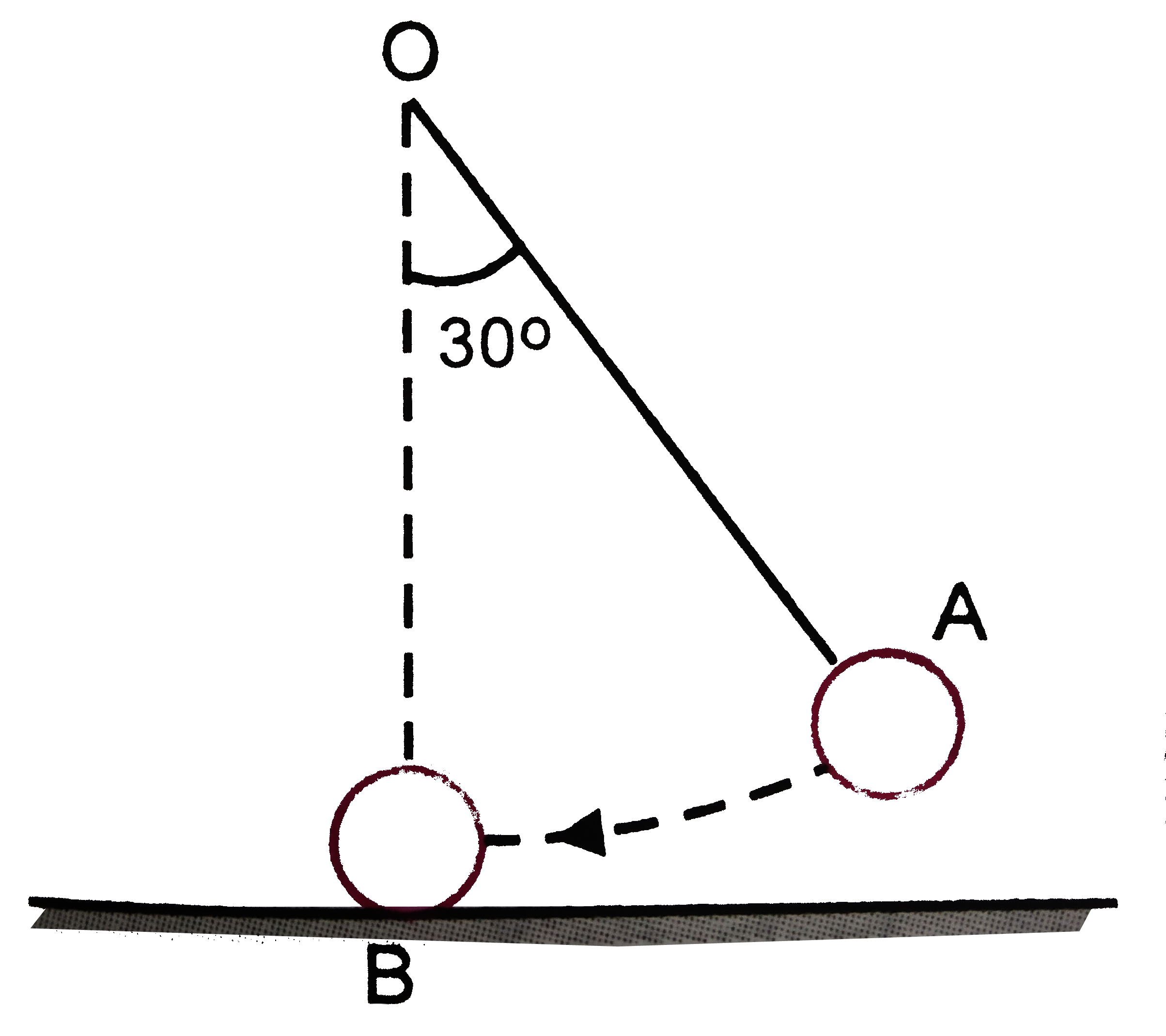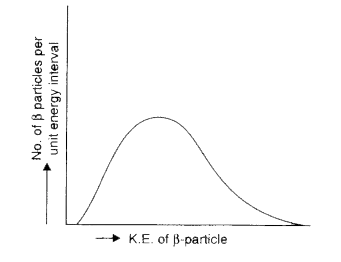NCERT EXERCISES WITH SOLUTIONS from PRADEEP PHYSICS Chapter 12 WORK, ENERGY AND POWER for Class 11
| Class 11 | PHYSICS |
| Chapter | WORK, ENERGY AND POWER |
| PRADEEP PHYSICS | NCERT EXERCISES WITH SOLUTIONS |
| Medium | English |
| Academic Year | 2023-2024 |
Question 1
The sign of work done by a force on a body is important to understand. State carefully if the following quantities are poisitve or negative :
(a) Work done by a man in lifting a bucket out of a well by means of a rope tied to the bucket.
(b) Work done by gravitational force in the above case. (c ) Work done by friction on a body sliding down an iniclined plane.
(d) Work done by an applied force on a body moving on a rough horizontal plane with uniform velocity.
(e) Work done by the resistive force of air on a vibrating pendulum in bringing it to rest. View SolutionQuestion 2
A body of mass 2 kg initially at rest moves under the action of an applied horizontal force of 7N on a table with coefficient of kinetic friction =0.1. Calculate the
(a) work done by applied force in 10s. (b) work done by friction in 10s.
(c ) work done by the net force on the body in 10s.
(d) change in K.E. of body in 10s, and interpret your result. View SolutionQuestion 3
Given in fig are examples of some potential energy functions in one dimension. The total enrgy of the particle is indicated by a cross on the ordinate axis. In each case, specify the regions, if any, in which the particle cannot be found for the given energy. Also, indicate the minimum total energy the particle must have in each case. Think of simple physical contexts for which these potential energy shapes are relevant.
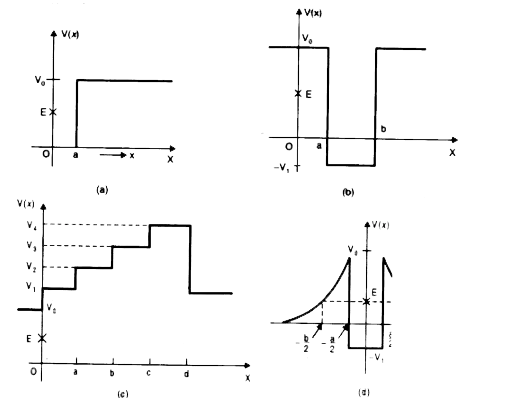 View Solution
View SolutionQuestion 5
Answer the following:
a) The casing of a rocket in flight burns up due to friction. At whose expense is the heat required for burning obtained? The rocket or the atmosphere?
b) Comets move around the sun in highly elliptical orbits. The gravitational force on the comet due to the sun is not normal to the comet's velocity in general. Yet the work done by the gravitatonal force over every complete orbit of the comet is zero. Why?
c) An artificial satellite orbiting the earth in very atmosphere loses its energy grdually due to dissipation against atmospheric resistance, howerver small. Why then does its speed increase progressively as it comes closer and closer tothe earth? d)In fig i) the man walks 2m carrying a mass of 15 kg on his hands. In Fig ii) he walks the same distance pulling the rope behind him. The rope goes over pulley, and a mass of 15 kg hangs at its other end. In which case is the work done greater?
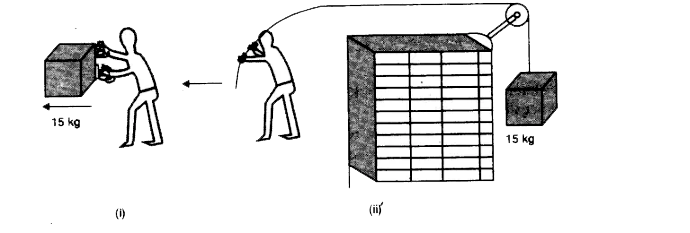 View Solution
View SolutionQuestion 6
Underline the correct alterntaive:
a) when a conservative force does positivie work on a body, the potential energy of the body increase/decreases/remains unaltered.
work done by a body against friction always results in a loss of its kinetic /potential energy.
c) The rate of change of total momentum of a many-particle system is proportional to the external force/ sum of the internal forces on the system.
d) In an inelastic collision of two bodies, the quantities which do not change after the collision are the total kinetic energy/total linear momentum/total enregy of the system of two bodies. View SolutionQuestion 7
State if each of the following statements is true or false. Give reasons for your answer.
a) In an elastic collision of two bodies, the momentum and energy of each body is conserved.
b)Total energy of a systm is always conserved,no matter what internal and external forces on the body are present.
Work done in the motion of a body over a closed loop is zero for every force in nature.
d) In an inelastic collision, the final kinetic energy is always less than the initial kinetic energy of the sytem. View SolutionQuestion 8
Anwer carefully, with reasons:
a) In an elastic collision of two billiard balls, is the total kinetic energy conserved during the short time of collision of the balls (i.e. when they are in contact)?
Is the total linear momentum conserved during the short time of an elastic collision of two balls?
c) What are the answers to a) and b) for an inelastic collision?
d) If the potenital energy of two billiard balls depends only on the separation distance between their centers, is the collision elastic or inelastic? (note we are talking here of potential energy corresponding to the force during collision, not gravitational potential energy).View SolutionQuestion 11
A body constrained to move along the z-axis of a co-ordinate system, is subjected to a constant force →F given by →F=−ˆi+2ˆj+3ˆk Newton where ˆi,ˆjand ˆk represent unit vectors along x-,y-,and z-axes of the system, respectively. Calculate the work done by this force in displacing the body through a distance of 4m along the z-axis.View SolutionQuestion 12
An electron and a proton are detected in a cosmic ray experiment, the first with kinetic energy 10 keV and second with 100keV. Which is faster, the electron or proton ? Obtain the ratio of their speeds. Take mass of electron 9.11×10−31kg. Mass of proton =1.67×10−27kg and 1eV=1.6×10−19J.View SolutionQuestion 13
A rain drop of radius 2mm, falls from a height of 500 m above the ground. It falls with decreasing acceleration due to viscous resistance of air until half its original height. It attains its maximum (terminal ) speed, and moves with uniform speed there after. What is the work done by the gravitational force on the drop in the first half and second half of its journey ? Take density of water =103kg/m3. What is the work done by the resistive force in the entire journey if its speed on reaching the ground is 10ms−1 ?View SolutionQuestion 16
Two identical ball bearings in contact with each other and resting on a frictionless table are hit head on by another ball bearing of the same mass moving initially with a speed v, figure,. If the collision is elastic, which of the following is a possible result after collisioin?
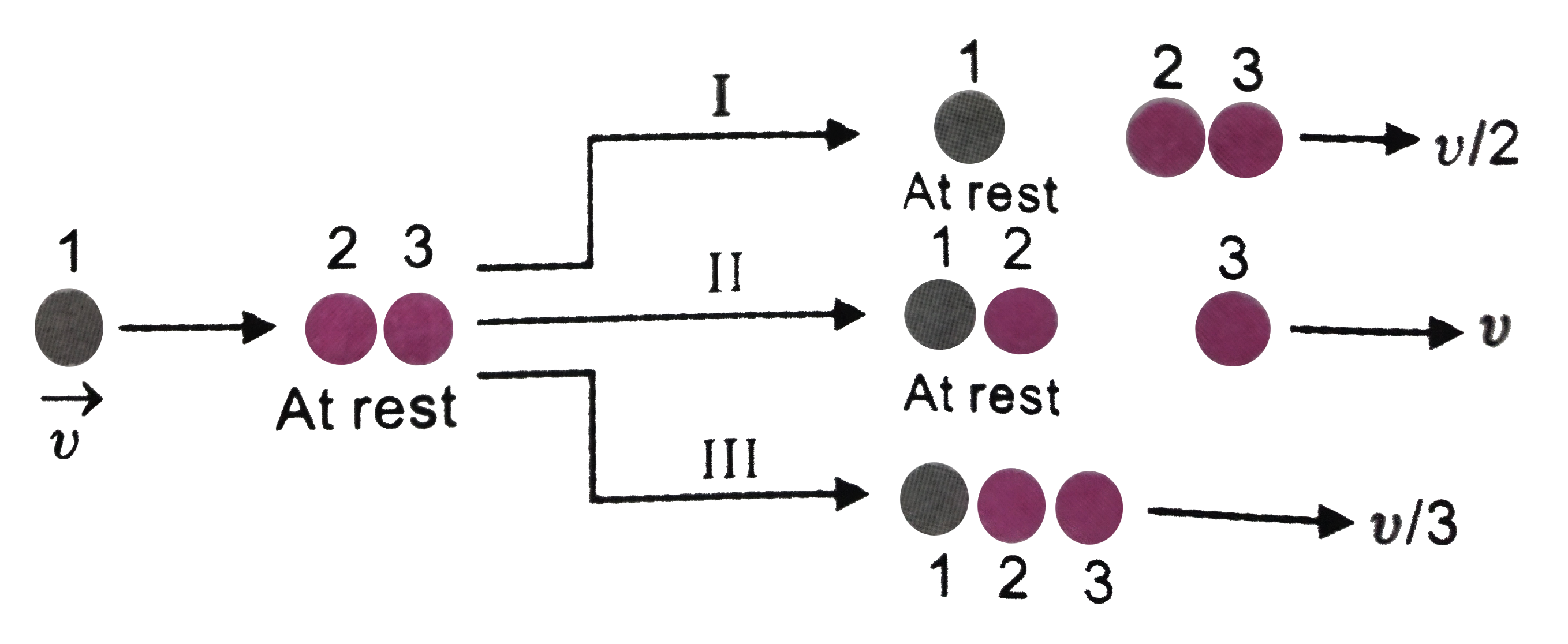 View Solution
View SolutionQuestion 18
The bob A of a simple pendulum is released from a horizontal position A as shownin in figure. If the length of the pendulum is 1.5m , what is the speed with which the bob arrives at the lowermost point B, given that it dissipates 5% of its initial energy against air resistance ?
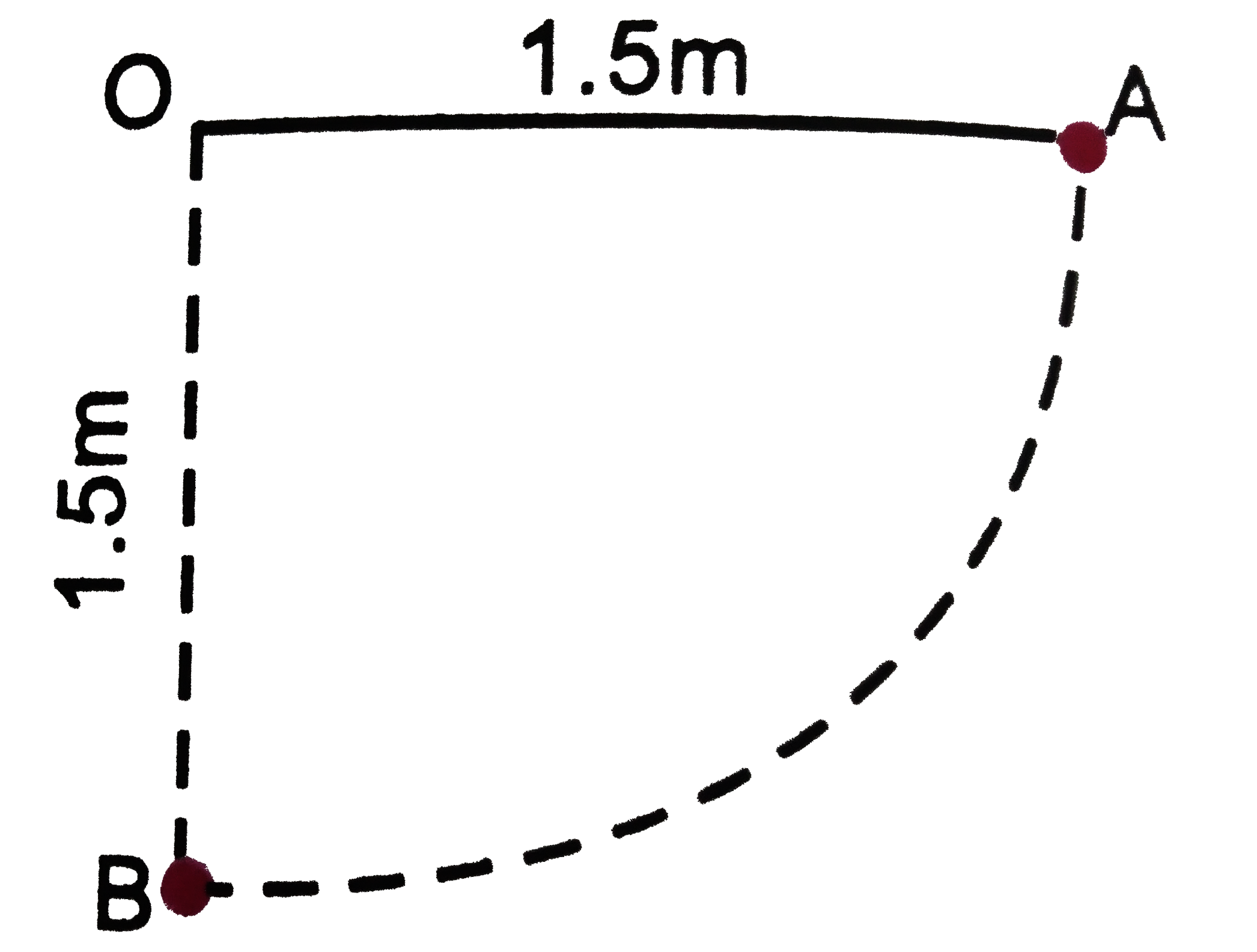 View Solution
View SolutionQuestion 19
A trolley of mass 300 ks carrying a sand bag of 25 kg is moving uniformly with a speed of 27km/h on a frictionless track. After a while, sand starts leaking out of a hole on the trolley's floor at the rate of 0.05kgs−1. What is the speed of the trolley after the entire sand bag is empty ?View SolutionQuestion 21
The blades of a windmill sweep out a circle of area A. (a) If the wind flows at a velocity υ perpendicular to the circle, what is the mass of air passing through it in time t? (b) What is K.E. of the air ? (c) Assume that the wind mill converts 25% of the wind's energy into electrical energy , and that A=30m2,υ=36km/h and the density of air is 1.2kg/m3. What is electrical power produced ? View SolutionQuestion 22
A person trying to lose weight (dieter ) lifts a 10 kg mass through 0.5m, 1000 times, A ssume that the potential energy lost each time she lowers the mass is dissipated (a) How much work does she does against the gravitational force ? (b) Fat supplies 3.8×107J of energy per kilogram which is converted to mechanical energy with a 20% efficiency rate. How much fat will the dieter use up ?View SolutionQuestion 23
A family uses 8kW of power. (a) Direct solar energy is incident on the horizontal surface at an average rate of 200 W per square metre. If 20% of this energy can be converted to useful electrical energy, how large an area is needed to supply 8kW? (a) Compare this area to that of the roof of a typical house. View SolutionQuestion 24
A bullet of mass 0.012 kg and horizontal speed 70ms−1 strikes a block of wood of mass 0.4 kg and instantly comes to rest with respect to the block. The block is suspended from the ceiling by thin wire. Calculate the height to which the block rises. Also, estimate the amount of heat produced in the block. View SolutionQuestion 26
A 1kg block situated on a rough incline is connected to a spring of spring constant 100Nm−1 as shown in figure,. The block is released from rest with the spring in the unstretched position. The block moves 10cm down the incline before coming to rest. Find the coefficient of friction between the block and the incline. Assume that the spring has negligible mass and the pulley is frictionless.
 View Solution
View SolutionQuestion 27
A bob of mass 0.3 kg falls from the ceiling of an elevator moving down with a uniform speed of 7ms−1. If hits the floor of the elevator (length of the elevator = 3m) and does not rebound. What is the heat produced by the impact ? Would your answer be different if the elevator were stationary ?View SolutionQuestion 28
A trolly of mass 200kg moves with a uniform speed of 36 km/h on a frictionless track. A child of mass 20kg runs on the trolly from one end to the other (10m away) with a speed of 4m/s relative to the trolly in a direction opposite to the trolly's motion and jumps out of the trolly. How much has teh trolly moved from the time the child begins to run ?View Solution
All Exercises from PRADEEP PHYSICS Class 11 PHYSICS WORK, ENERGY AND POWER
- Additional Exercises
- Advanced Problems For Competitions
- Assertion-Reason Type Questions
- Comprehension
- Conceptual Problems
- Curiosity questions
- Fill in the blanks
- Integer Type Questions
- JEE (Main and Advanced)
- Long Answer Question
- Multiple choice question
- NCERT EXERCISES WITH SOLUTIONS
- NCERT( Multiple choide questions-1)
- Problems For Practice
- SAMPLE PROBLEM
- Short Answer Question
- Very Short Anwer Question.
- higher order thinking skills
- solved examples
- value Based Question

